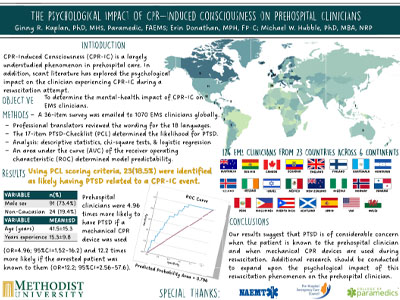ABSTRACTS
The Psychological Impact of CPR-Induced Consciousness on Prehospital CliniciansAuthor: Ginny Kaplan, Erin Donathan, and Michael W. Hubble | | Associate Authors:
Introduction: CPR-induced consciousness (CPR-IC) is a largely understudied phenomenon in prehospital care. In addition, scant literature has explored the psychological impact on the clinician experiencing CPR-IC during a resuscitation attempt. Objective: To determine the mental-health impact of CPR-IC on emergency medical services (EMS) clinicians. Methods: A 36-item QualtricsXM survey was globally emailed to roughly 1070 prehospital clinicians by the National Association of Emergency Medical Technicians and the Irish Pre-hospital Emergency Care Council. To ensure translation accuracy, professional translators were sourced to review the wording for each of the 18 provided languages. The 17-item PTSD-Checklist (PCL) was used to determine the likelihood of the respondent having PTSD. Descriptive statistics were generated for the overall sample, and chi-square analyses were performed to determine univariate relationships. A logistic regression determined predictors of PTSD in this population while controlling for potential confounders. An area under the curve (AUC) of the receiver operating characteristic (ROC) was computed to determine model predictability. Results: Overall, 124 prehospital clinicians representing 23 countries and six continents responded to the survey. Of these, 91 (73.4%) were male and 24 (19.4%) were non-Caucasian. The average respondent age was 41.5 ± 15.3 years with 15.3 ± 9.8 years of experience. Using PCL scoring criteria, 23 (18.5%) were identified as likely having PTSD related to a CPR-IC event. Prehospital clinicians were 4.96 times more likely to have PTSD if a mechanical CPR device was used (OR = 4.96, 95% CI = 1.52–16.2) and 12.2 times more likely if the arrested patient was known to them (OR = 12.2, 95% CI = 2.56–57.6). The AUC showed good predictability at 0.796. Conclusions: Our results suggest that PTSD is of considerable concern when the patient is known to the prehospital clinician and when mechanical CPR devices are used during resuscitation. Additional research should be conducted to expand upon the psychological impact of this resuscitation phenomenon on the prehospital clinician.
|

